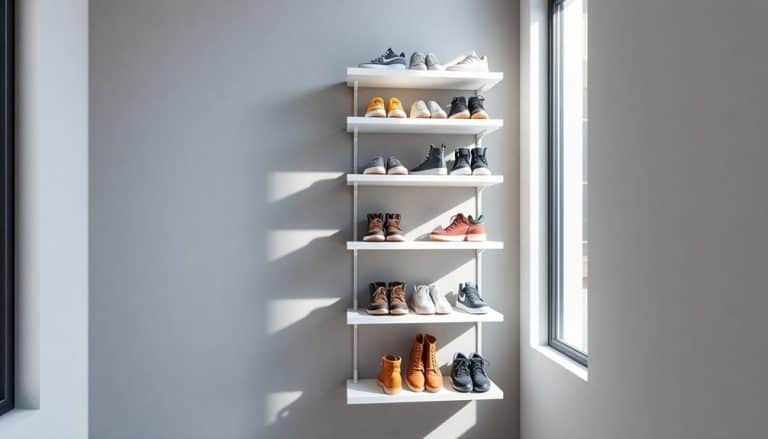This website contains affiliate links. Some products are gifted by the brand to test. As an Amazon Associate, I earn from qualifying purchases. The content on this website was created with the help of AI.
You’ll need an extensive storage system that combines vertical and horizontal organization to maximize your hobby space. Start by categorizing materials based on use frequency and type, then invest in clear storage bins, drawer units, and pegboards for ideal visibility and access. Use a label maker or permanent markers to create detailed identification systems, and consider portable solutions like rolling carts for flexibility. Stackable containers with secure latches work well for transport, while over-door organizers and magnetic strips help utilize every inch of space. These fundamental organization strategies will set the foundation for exploring even more advanced storage solutions.
Key Takeaways
- Use clear plastic bins with secure lids to keep materials visible, protected from dust, and easily accessible when needed.
- Install pegboards on walls with adjustable hooks to maximize vertical space and customize tool organization as needs change.
- Implement a color-coding system with labels to quickly identify and categorize different types of materials and supplies.
- Invest in rolling storage carts for mobility and flexibility, allowing easy transport of supplies between workspaces.
- Create modular storage solutions with adjustable shelving to accommodate different-sized containers and growing collections over time.
Choosing the Right Storage Systems

The selection of appropriate storage systems begins with analyzing your specific hobby materials and workspace constraints. You’ll need to assess the size, quantity, and fragility of your items, along with considering how frequently you access them. Factor in your available floor space, wall space, and whether you need mobile or stationary solutions.
Consider modular systems that can grow with your collection. Clear plastic bins work well for items you need to identify quickly, while drawer units offer protection from dust and easy access. For smaller items like beads, threads, or paint tubes, opt for compartmentalized organizers with adjustable dividers. Vertical storage solutions, such as pegboards or wall-mounted shelves, maximize space efficiency in tight areas.
Don’t overlook specialized storage options designed for specific hobbies. Paper crafters might benefit from vertical paper organizers, while model builders may need shallow drawers for delicate parts. Choose containers with proper seals for moisture-sensitive materials, and select drawer slides rated for heavier items like tools or pottery supplies. Remember to prioritize storage systems that allow quick retrieval and maintain proper organization during use. Clear plastic organizers offer superior visibility and versatility while maintaining a break-resistant construction for long-term durability.
Labeling and Categorization Methods

Effective labeling and organization within your storage system depends upon establishing clear, consistent categorization methods from the start. You’ll need to group your materials by type, frequency of use, project association, or color scheme – whichever makes the most sense for your hobby. Create primary categories first, then break them down into subcategories that are specific enough to be useful but broad enough to remain practical.
Use a labeling system that’s both durable and easy to read. You can opt for a label maker for professional-looking tags, or write directly on containers with permanent markers. Consider using color-coding to quickly identify different categories – for example, blue labels for tools, red for raw materials, and green for finished items. Don’t forget to label both the front and top of containers for easy identification from multiple angles.
Include essential information on your labels such as contents, quantity, date of purchase for perishables, and any special handling instructions. If you’re storing items in clear containers, place labels where they won’t obstruct the view of the contents while remaining easily visible. For children’s toys and craft supplies, consider using fun storage bins that combine functionality with playful designs to make organization more engaging.
Vertical Storage Space Solutions

Maximizing wall space in your hobby area opens up countless storage possibilities that free up valuable floor and table surfaces. You’ll find that vertical storage systems can accommodate a wide range of materials while keeping them visible and easily accessible.
Install adjustable shelving units with different shelf depths to store containers of varying sizes. Mount pegboards to display frequently used tools, and add hooks, baskets, and specialized holders that you can reconfigure as needed. Consider using over-the-door organizers with clear pockets for small items like paint tubes, brushes, and crafting supplies.
Wire grid panels offer excellent versatility – attach them directly to walls and customize with clips, hooks, and bins. You’ll maximize corner spaces by installing floating corner shelves or triangular cabinet units. For fabric and paper storage, mount tension rods between shelves to create hanging file systems.
Don’t overlook the backs of doors and cabinet surfaces. Install magnetic strips for metal tools, or add narrow rack systems for patterns and templates. Remember to position frequently used items at eye level, with seasonal or rarely used materials stored higher up. Stylish wall hooks can elevate the look of your storage space while providing practical hanging solutions for backpacks and supplies.
Portable Organization Tools

Crafters who frequently move between workspaces need portable storage solutions that keep supplies organized and protected during transport. Rolling carts with multiple drawers offer flexible storage while remaining easy to move. You’ll find these carts in various sizes, with some featuring removable bins and adjustable compartments that adapt to your specific needs.
Tool bags and art supply cases provide another practical option for mobile organization. Look for ones with reinforced bottoms, multiple pockets, and padded compartments to protect delicate materials. Many feature removable dividers and clear pockets, making it simple to locate items quickly.
For smaller supplies, tackle boxes and compartmentalized containers work exceptionally well. You can customize these with removable dividers to store beads, threads, paint tubes, or other small items. Consider stackable containers with secure latches to prevent spills during transport. They’re particularly useful when you need to bring only specific materials to a project site.
Portable craft stations with fold-out surfaces give you both storage and workspace. These units typically include built-in organizers, expandable compartments, and sturdy wheels for easy movement between locations. Portable storage carts come in various designs to meet diverse organizational requirements from crafting to general household use.
Small Space Storage Strategies

Anyone working with limited space can transform tight quarters into efficient craft storage areas through smart vertical planning. By maximizing wall space and using multi-functional furniture, you’ll create organized zones without sacrificing your work area. Install adjustable shelving systems that can adapt as your storage needs change, and consider using door-mounted organizers to utilize often-overlooked spaces.
- Mount pegboards or slat walls to hold frequently used tools, creating easy access while keeping your workspace clear
- Install floating shelves at different heights to store supplies in clear containers, making items visible and reachable
- Use over-the-door shoe organizers with clear pockets to store small items like paint tubes, brushes, and crafting tools
- Convert closet spaces with modular cube storage units that can be reconfigured as needed
Don’t forget to look for furniture that serves multiple purposes, like ottoman storage benches or folding craft tables. Stack clear storage bins vertically when possible, and label everything clearly. Remember to measure your space carefully before purchasing storage solutions to guarantee they’ll fit properly and function effectively in your available area. Consider adding a 12-tier rolling cart to maximize vertical storage while maintaining mobility in tight spaces.
Frequently Asked Questions
How Often Should I Reorganize My Hobby Storage Systems?
Did you know that people waste up to 2.5 days a year searching for misplaced items? You’ll want to reorganize your storage systems quarterly, or whenever you notice inefficiencies in finding materials. Watch for signs like spending extra time looking for items, visible clutter building up, or materials spilling into other zones. Do a quick monthly check and adjust as your hobby needs evolve or when you acquire new supplies.
Can Humidity Affect Stored Craft Materials and What Precautions Should I Take?
Humidity can greatly damage your craft materials through mold growth, warping, and deterioration. You’ll need to store moisture-sensitive items like paper, fabric, and metal components in airtight containers with silica gel packets. Keep your materials in a climate-controlled space, aiming for 45-50% relative humidity. Install a dehumidifier if needed, and don’t store crafts in basements or attics where moisture levels fluctuate dramatically.
What’s the Average Cost to Set up a Basic Hobby Organization System?
You’ll need about $100-200 for a basic hobby organization system. Start with clear plastic bins ($20-30), drawer units ($30-40), and stackable containers ($25). Add labeled dividers ($10), small boxes ($15), and storage cubes ($20-30). If you’re on a tighter budget, you can reduce costs by using repurposed containers and DIY solutions like mason jars or cardboard organizers.
How Do I Prevent My Children From Accessing Potentially Dangerous Craft Supplies?
Just as you’d lock up household cleaners, you’ll need to secure craft supplies that pose risks. Store sharp tools, toxic adhesives, and harmful chemicals in locked cabinets or toolboxes with combination locks. You can also use childproof latches, high shelving units, or dedicated craft rooms with keyed entry. Label hazardous items clearly and teach older children about safety protocols when they’re mature enough to handle supplies responsibly.
Should I Insure My Extensive Collection of Hobby Materials and Supplies?
If you’ve invested considerably in hobby materials, it’s wise to insure your collection. First, document everything with photos and detailed receipts. You’ll want to contact your homeowner’s or renter’s insurance provider to discuss coverage options. Some collections may require additional riders or specialized policies. Don’t forget to update your inventory annually and adjust coverage as your collection grows in value.




